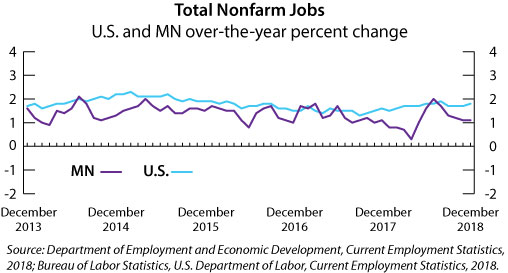by Nick Dobbins
January 2019
Monthly analysis is based on unadjusted employment data.
Employment in the Minneapolis-St. Paul-Bloomington MSA was off by 14,598 (0.7 percent) in December. Mining, Logging, and Construction led the declines in both real and proportional terms as the supersector lost 7,661 jobs (8.8 percent). Educational and Health Services lost 3,318 jobs (1 percent), and Government employers lost 3,244 (1.2 percent). Notable increases included Trade, Transportation, and Utilities, which was up 2,343 (0.6 percent) with growth in all three component sectors, and Other Services added 547 jobs (0.7 percent) thanks to a strong showing from Religious, Grantmaking, Civic, Professional, and Similar Organizations (up 535, 1.2 percent). Over the year the metro area added 31,804 jobs (1.6 percent). This was the second largest proportional over-the-year increase of any MSA in the state and outpaced the statewide over-the-year growth of 1.1 percent. Trade, Transportation, and Utilities added 12,150 jobs (3.3 percent) with growth in all three sectors, Mining, Logging, and Construction added 3,419 (4.5 percent), and Manufacturing added 6,325 (3.2 percent). Of the 10 published supersectors, only two had negative job growth: Educational and Health Services, which lost 3,856 jobs (1.1 percent) thanks to declines in Health Care and Social Assistance, and Information, which lost 100 jobs (0.3 percent).
The Duluth-Superior MSA lost 1,482 jobs (1.1 percent) in December. Losses were spread among a number of industries, as just two supersectors showed positive growth and only by a combined 91 jobs. The sharpest decline came in Mining, Logging, and Construction (off by 443 jobs or 4.7 percent). Government employers lost 399 jobs (1.4 percent), and Leisure and Hospitality was off by 255 (1.8 percent). Over the year the Duluth MSA added 1,504 jobs (1.1 percent), placing it at roughly the same over-the-year rate as Minnesota as a whole. Duluth’s growth was spread among many industries. Notable supersectors included Other Services (up 209 jobs or 3.2 percent), Trade, Transportation, and Utilities (up 362, 1.4 percent), and Leisure and Hospitality (up 394, 2.9 percent).
Employment in the Rochester MSA was up by 231 (0.2 percent) in December. This was the largest increase of any MSA in the state, and Rochester was one of only two MSAs to have job growth on the month (Mankato). Educational and Health Services added 478 jobs (1 percent), breaking its streak of five consecutive months with negative job growth. Manufacturers also had notable gains, adding 110 jobs (1.1 percent). On the year the Rochester area lost 248 jobs (0.2 percent). It was the only MSA in the state with over-the-year job losses. The decline was driven primarily by the loss of 1,641 jobs (3.3 percent) in Educational and Health Services. Alternately, Leisure and Hospitality added 800 jobs (7.5 percent) on the year.
Employment in the Saint Cloud MSA was off by 861 (0.8 percent) in December. Mining, Logging, and Construction lost 228 jobs (3.2 percent), and Government lost 236 (1.5 percent). Professional and Business Services lost 102 jobs (1.1 percent). Three supersectors had positive monthly growth, but only added 33 total jobs among them. Annually the St. Cloud MSA added 1,036 jobs (0.9 percent). Mining, Logging, and Construction and Manufacturing remained the big drivers of growth, adding 566 jobs (9.1 percent) and 439 jobs (2.8 percent), respectively.
The Mankato-North Mankato MSA added 56 jobs (0.1 percent) in December. It was one of only two MSAs in the state to add jobs on the month. Mankato’s growth was driven by service providers, which added 167 jobs (0.3 percent), while their counterparts in goods production lost 111 jobs (1 percent). Annually the Mankato area added 2,379 jobs (4 percent). This was the largest proportional over-the-year growth of any MSA in the state. Both public and private sector employers contributed to the growth, adding 1,337 jobs (2.7 percent) and 1,042 jobs (10.7 percent), respectively.
Employment in the Fargo-Moorhead MSA was down by 539 (0.4 percent) in December. As was the case across the state, overall employment growth was pushed downward by steep declines in Mining, Logging, and Construction employment (off by 881, 9.4 percent). The only other supersector to add or lose more than 1 percent of its jobs was Information, which was down by 2.5 percent or 74 total jobs. Annually the Fargo-Moorhead MSA added 1,687 jobs (1.2 percent). Mining, Logging, and Construction added 336 jobs (4.1 percent), the largest growth of any supersector.
The Grand Forks-East Grand Forks MSA lost 693 jobs (1.2 percent) in December. It was the steepest over-the-month decline of any MSA in the state. Mining, Logging, and Construction drove the losses, off by 263 (8.6 percent). Only two supersectors added jobs. Financial Activities was up by 42 (2.2 percent). Annually the MSA added 487 jobs (0.9 percent). Leisure and Hospitality led the way, adding 679 jobs (11.9 percent). Government employment declined the most, off by 500 (3.5 percent) thanks to a loss of 469 jobs in State Government.
